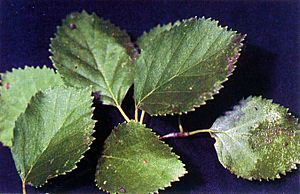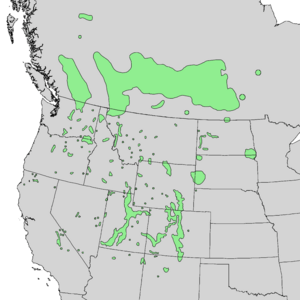Water birch facts for kids
Quick facts for kids Water birch |
|
|---|---|
 |
|
| Foliage | |
| Scientific classification | |
| Genus: |
Betula
|
| Species: |
occidentalis
|
 |
|
| Natural range of Betula occidentalis | |
| Synonyms | |
|
|
The water birch or red birch (scientific name: Betula occidentalis) is a type of birch tree. It grows naturally in western North America. You can find it in Canada, from Yukon to western Ontario. In the United States, it grows from eastern Washington to western North Dakota. It also grows south to eastern California, northern Arizona, northern New Mexico, and southwestern Alaska. This tree usually grows near streams in mountain areas.
Contents
About the Water Birch
The water birch is a deciduous shrub or a small tree. This means it loses its leaves every year. It can grow up to 10 meters (about 33 feet) tall. Often, it has many trunks instead of just one.
What It Looks Like
The bark of the water birch is dark red-brown to blackish. It feels smooth and does not peel off like some other birch trees. Its small branches, called twigs, are smooth or slightly hairy. They do not have a smell when you scratch them.
The leaves grow in an alternating pattern along the branch. They are shaped like an egg or a diamond. Each leaf is about 1 to 7 centimeters (0.4 to 2.8 inches) long. They are also about 1 to 4.5 centimeters (0.4 to 1.8 inches) wide. The edges of the leaves are jagged, like a saw. Each leaf has two to six pairs of veins. They have a short stem, called a petiole, up to 1.5 centimeters (0.6 inches) long.
Flowers and Seeds
The water birch has flowers that are pollinated by the wind. These flowers grow in long, hanging clusters called catkins. They are usually 2 to 4 centimeters (0.8 to 1.6 inches) long. The male catkins hang down, while the female catkins stand upright.
After flowering, the tree produces fruit. The fruit is about 2 to 3 centimeters (0.8 to 1.2 inches) long and 8 to 15 millimeters (0.3 to 0.6 inches) wide. It contains many tiny seeds. These seeds have wings and are packed between the parts of the catkin.
Special Features
The water birch has a strong tendency to grow many small branches from its main trunk. This is called epicormic growth. It makes the wood full of small knots.
Sometimes, other similar birch trees in Alaska are confused with the water birch. Some people think they are the same. Others believe they are hybrids, which means they are a mix of different birch types. For example, they might be a mix of Betula neoalaskana and Betula glandulosa.
Uses and Importance
Some Plateau Indian tribes used parts of the water birch. They used it to help treat pimples and sores. The leaves of the water birch are also eaten by animals like sheep and goats.
Images for kids




